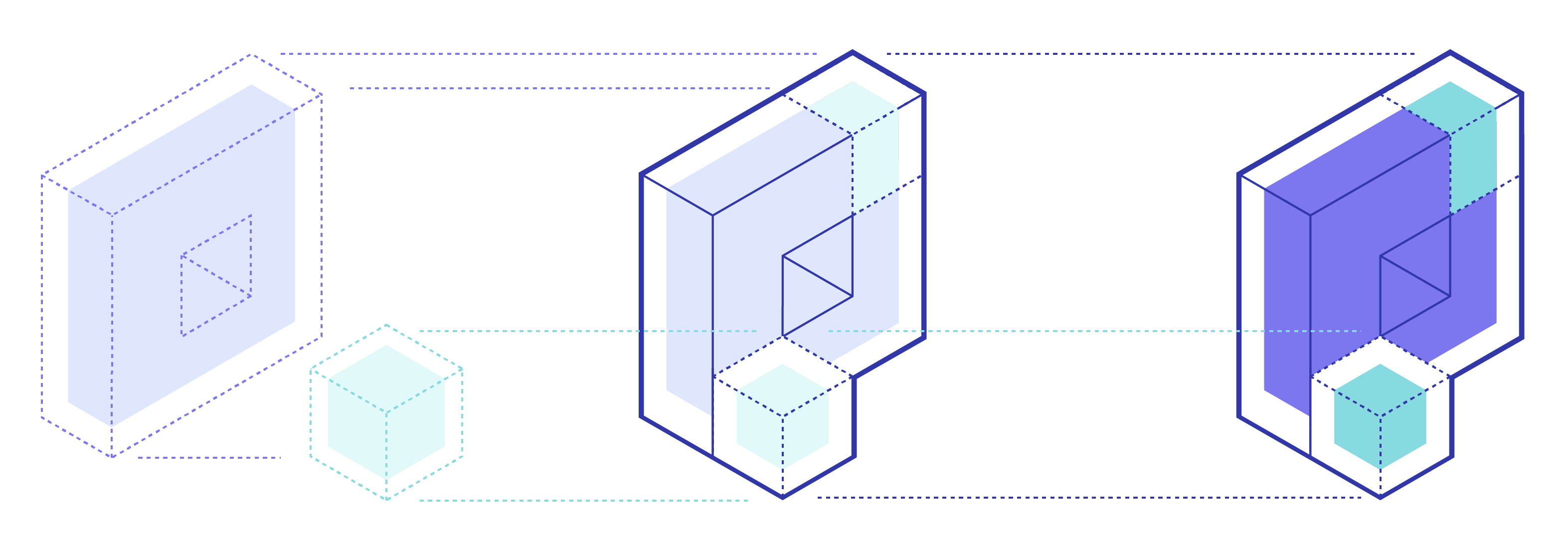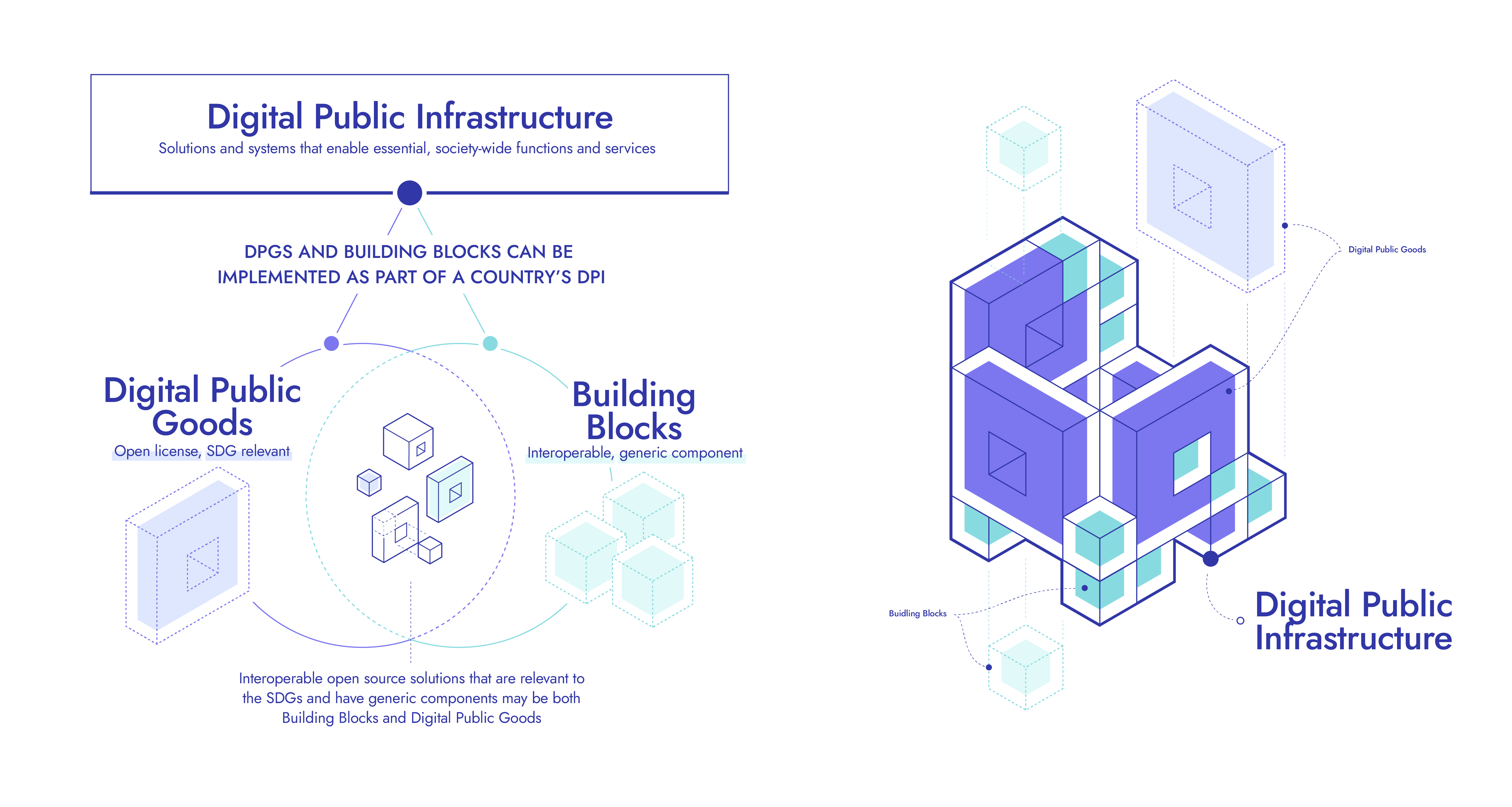Unpacking concepts & definitions – digital public Infrastructure, building blocks, and their relation to digital public goods

Strengthening the digitization of government services is critical for governments working to attain the Sustainable Development Goals (SDGs). The last few decades have seen a surge in these services, from cash transfers to digital IDs and even the development of automated emails from governments to citizens. As a result, many countries have been able to broaden the reach of government assistance, foster greater financial inclusion, and, as seen throughout the COVID-19 pandemic, quickly respond to and support their citizens in the face of new challenges. However, while many countries have quickly adapted and implemented new digital functions and services, this is far from the reality for all countries. This underscores a need to identify which technologies are working and how they can shape future implementation.
The way technologies are designed, developed, and governed matters – especially when determining the cost, efficiency, and interoperability of these services. Traditionally, governments have used siloed approaches when developing digital solutions for services and functions – this benefited one specific service or ministry at a time, overlooking the need for interoperability throughout government and with the private sector. This results in inefficient, vertical approaches to digital development.
Today, more and more governments are choosing instead to take a whole-of-government approach, also known as a GovStack, which involves digital solutions layered on top of one another making each layer more impactful and powerful than each solution alone.
This approach to digital development brings new opportunities for countries seeking to digitally transform and evolve. However, alongside these new approaches, there are new terms and concepts, many of which have not yet been well defined. In order to enable effective collaboration and alignment across these approaches, it is necessary to first arrive at a set of common definitions.
In 2021, the Digital Public Goods Alliance (DPGA) convened the GovStack Community of Practice (CoP), co-chaired by GIZ (Deutsche Gesellschaft für Internationale Zusammenarbeit). The purpose of this CoP is to identify and support the advancement of digital public goods with relevance to a “whole of government digital transformation approach”, or GovStack. This work is in direct support of the GovStack Initiative, which focuses on enabling countries to kickstart their digital transformation journey by adopting, deploying, and scaling digital government services.
In order to begin this work it became crucial to first create an aligned understanding of the key definitions and relationships between terms and concepts that are relevant to the GovStack CoP discussion, namely: digital public infrastructure, building blocks, and digital public goods.

With deep gratitude, we thank all the CoP members, listed below, for contributing to this conversation and helping to inform the relevant taxonomy to move this work forward. Below we outline the agreed definitions, showcase what they look like in practice, and demonstrate their relationship to one another. For a downloadable version of this overview with additional information please click here.
Digital Public Infrastructure (DPI)
Refers to solutions and systems that enable the effective provision of essential society-wide functions and services in the public and private sectors.
- This includes but is not limited to digital forms of ID and verification, civil registration, payment (digital transactions and money transfers), data exchange, and information systems (including sector-specific, i.e. health or education).
- A country’s digital public infrastructure may include implementations of multiple proprietary and/or open-source solutions (including digital public goods).
“The Philippines’ digital public infrastructure includes a digital identity system, called PhilSys which is an implementation of the digital public good MOSIP.”
“Estonia’s digital public infrastructure for digital data exchange is powered by X-Road which is a digital public good.”
Building Blocks
Refers to software code, platforms, and applications that are interoperable, provide a basic digital service at scale, and can be reused for multiple use cases and contexts.
- Serves as a component of a larger system or stack.
- They can be used to facilitate the delivery of digital public services via functions, which may include registration, scheduling, ID authentication, payment, data administration, and messaging.
- Building blocks can be combined and adapted to be included as part of a stack of technologies to form a country’s DPI.
- Building blocks may be open source or proprietary and therefore are not always DPGs.
“Building blocks can be as simple as a common set of rules or protocols (for example email programs like Simple Mail Transfer Protocol – SMTP), or complex (for example an open-source health information system like the DPG, District Health Information Software – DHIS2)“
Characteristics of building blocks:
- Autonomous: building blocks provide a standalone, reusable service or set of services, they may be composed of many modules/microservices.
- Generic: building blocks are flexible across use cases and sectors.
- Interoperable: building blocks must be able to combine, connect, and interact with other building blocks.
- Iterative evolvability: building blocks can be improved even while being used as part of solutions.
Digital Public Goods
Refers to open-source software, open data, open AI models, open standards, and open content that adhere to privacy and other applicable laws and best practices, do no harm by design, and help attain the Sustainable Development Goals (SDGs).
- DPGs may be implemented as a part of a country’s digital public infrastructure.
- When they provide a generic service at scale, DPGs may be considered building blocks.
- DPGs may also advance the SDGs but not contribute to public service delivery or be customisable across multiple use cases. Therefore, DPGs are not always building blocks and may not be implementable as digital public infrastructure.
“RapidPro is an open-source platform that facilitates the building of interactive messaging systems using a visual interface, it meets the DPG Standard and is, therefore, a DPG”
“OpenCRVS is a DPG software for civil registration, designed for low resource settings, it can be implemented by a government as part of digital public infrastructure”
Looking Ahead
Building on this common understanding the GovStack CoP will next begin identifying DPGs with relevance to the GovStack approach.
This work will culminate in a report identifying DPGs that governments can consider when developing government services using a whole-of-government approach.
With deep gratitude, we thank all the DPGA’s GovStack CoP members, listed below, for contributing to and helping to inform the taxonomy to move this work forward:
Allison Price (New America), Ameya Ashok Naik (eGov Foundation), Andrew Seely (IEEE), Anna Metz, (World Bank), Arvind Gupta, (Digital India Foundation), Ben Cerveny (Foundation for Public Code), Ben Grubb (UNICEF), Cathal Long (ODI), Chee Hau Tan (Singapore), Chi Ling Chan, (Singapore), David Eaves (Harvard Kennedy School), David Roos (GIZ/GovStack Initiative), Emily Middleton (Public Digital), Franziska Jakobs (GIZ), Gautham Ravichander (eGov Foundation), Govind Shivkumar (Omidyar Network), Hani Eskandar (ITU/GovStack Initiative), Jake Watson (DIAL/GovStack Initiative), Jameson Voisin (DPGA), Joanne Esmyot (Public Digital), Jonathan Marskell (World Bank), Kanwal Singh (Bill & Melinda Gates Foundation), Kevin O’Neil (Rockefeller Foundation), Keyzom Ngodup (UNDP), Kristin Little (IEEE), Liv Marte Nordhaug (DPGA), Lucy Harris (DPGA), Manish Srivastava (eGov Foundation), Marie Eichholtzer (World Bank), Martha Mundas (GIZ/GovStack Initiative), Maria Palombini (IEEE), Max Carlson (GovStack Initiative), Max Schumann (GIZ), Mei Lin Fung (People Centered Internet), Nico Lueck (GIZ/GovStack Initiative), Olaf Seidel (GIZ), Salome Eggler (GIZ), Sarah Fischer (GIZ/GovStack Initiative), Sean Blashke (UNICEF), Sherman Kong (DIAL/GovStack Initiative), Tamara Singh (W3CDD), Tim Wood (Bill & Melinda Gates Foundation), Uwe Wahser (GIZ/GovStack Initiative), Valerie Khan (D-EQ/GovStack Initiative), Viraj Tyagi (eGovFoundation), Vyjayanti Desai (World Bank), Yolanda Martínez (ITU/GovStack Initiative)